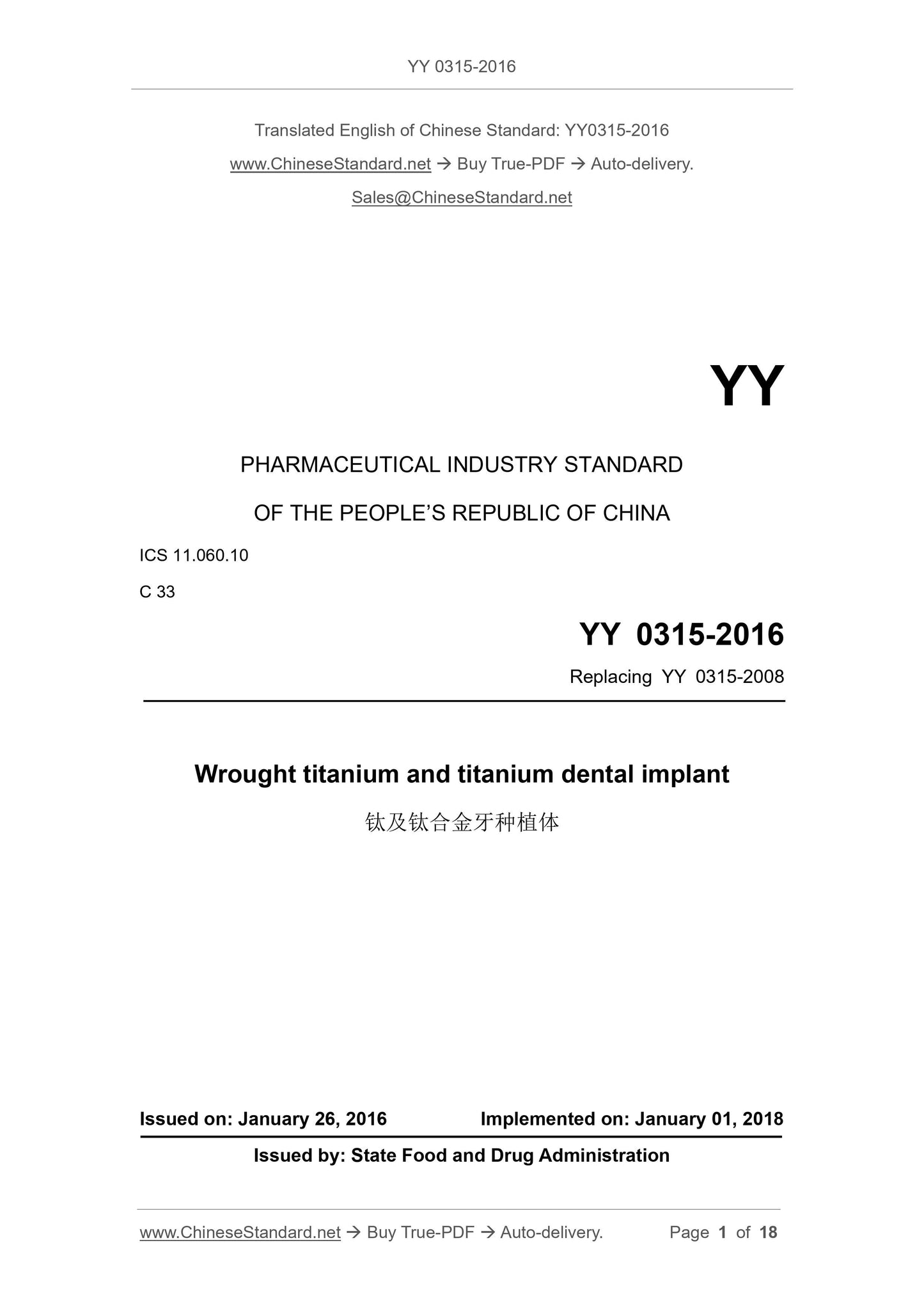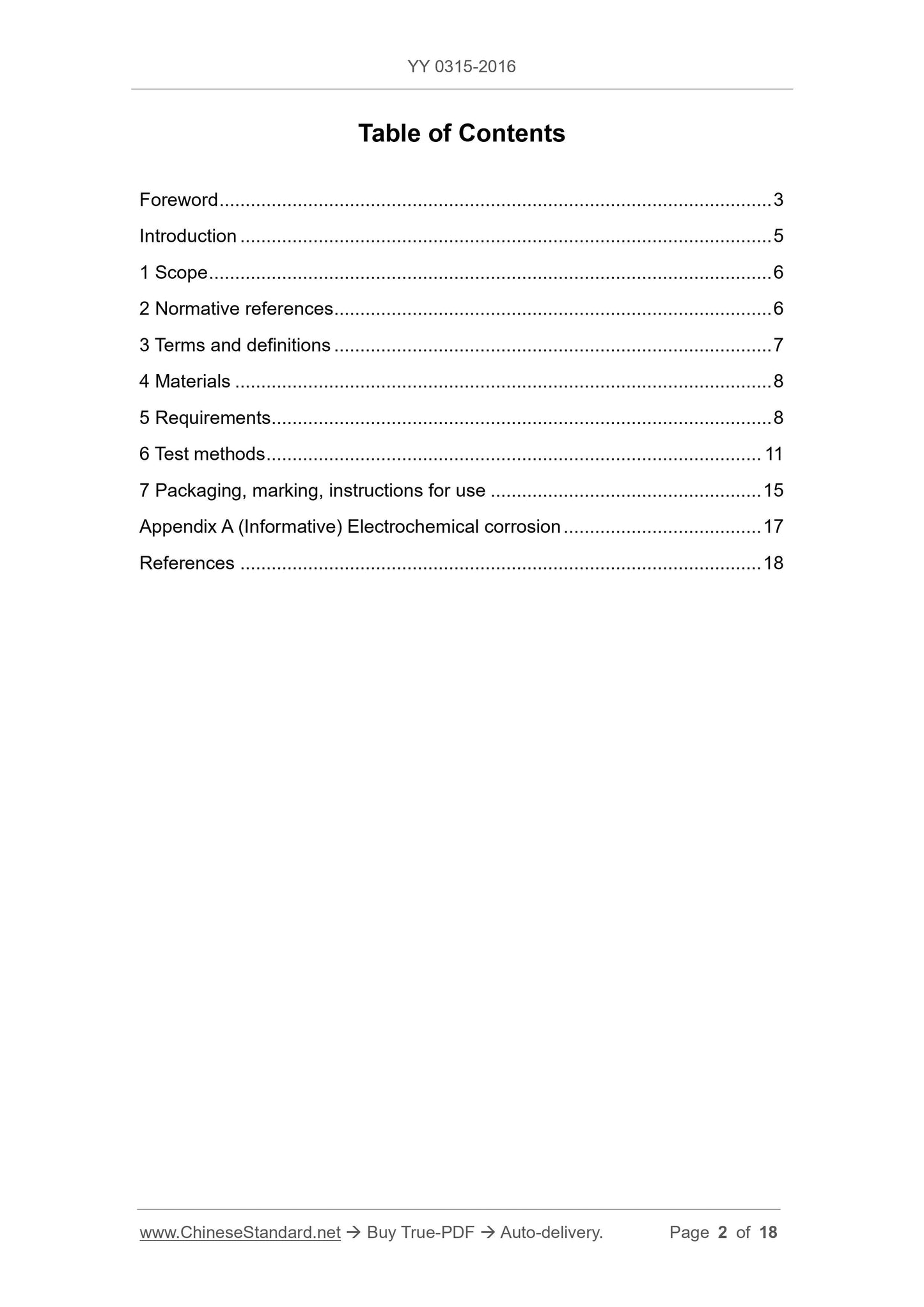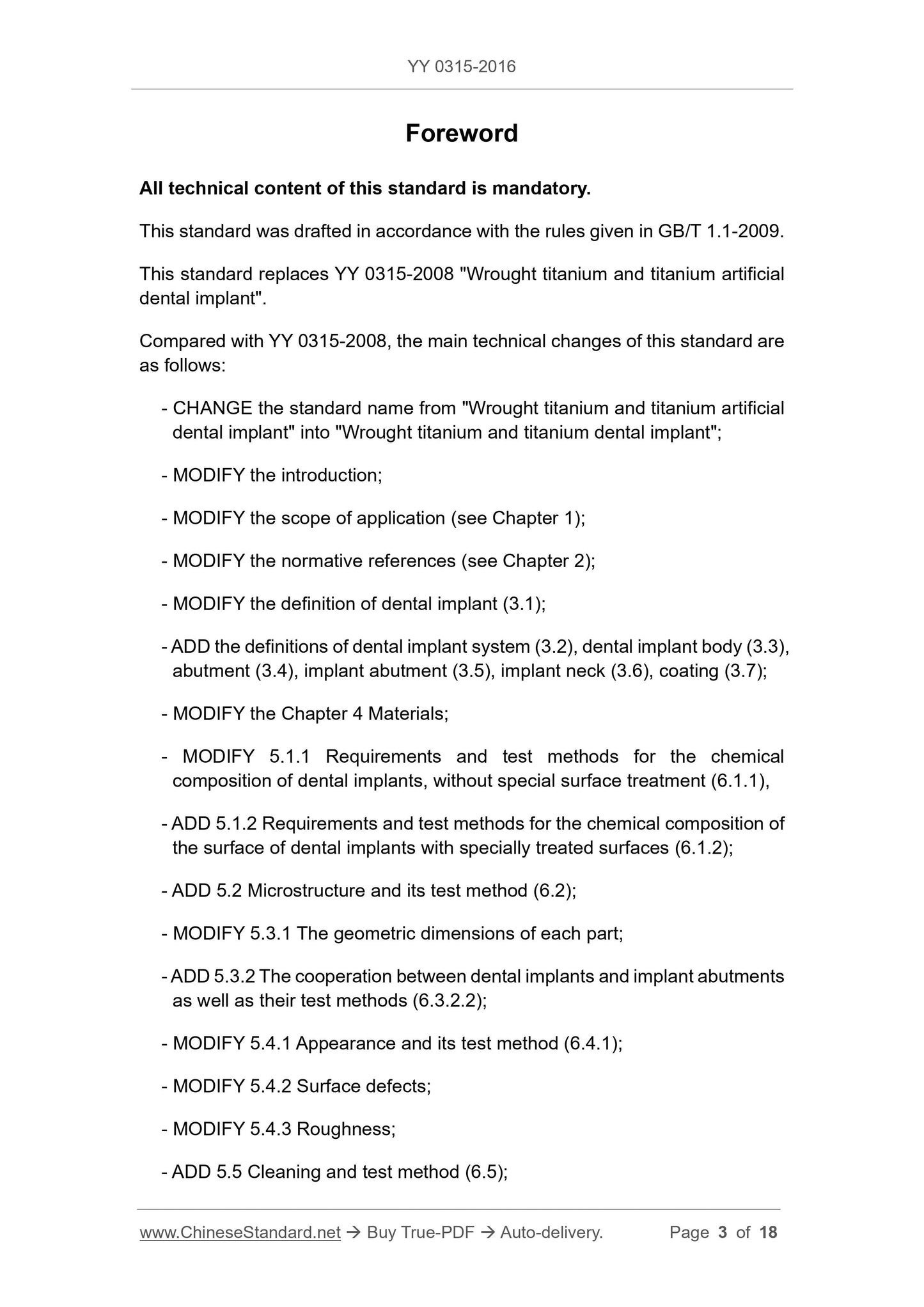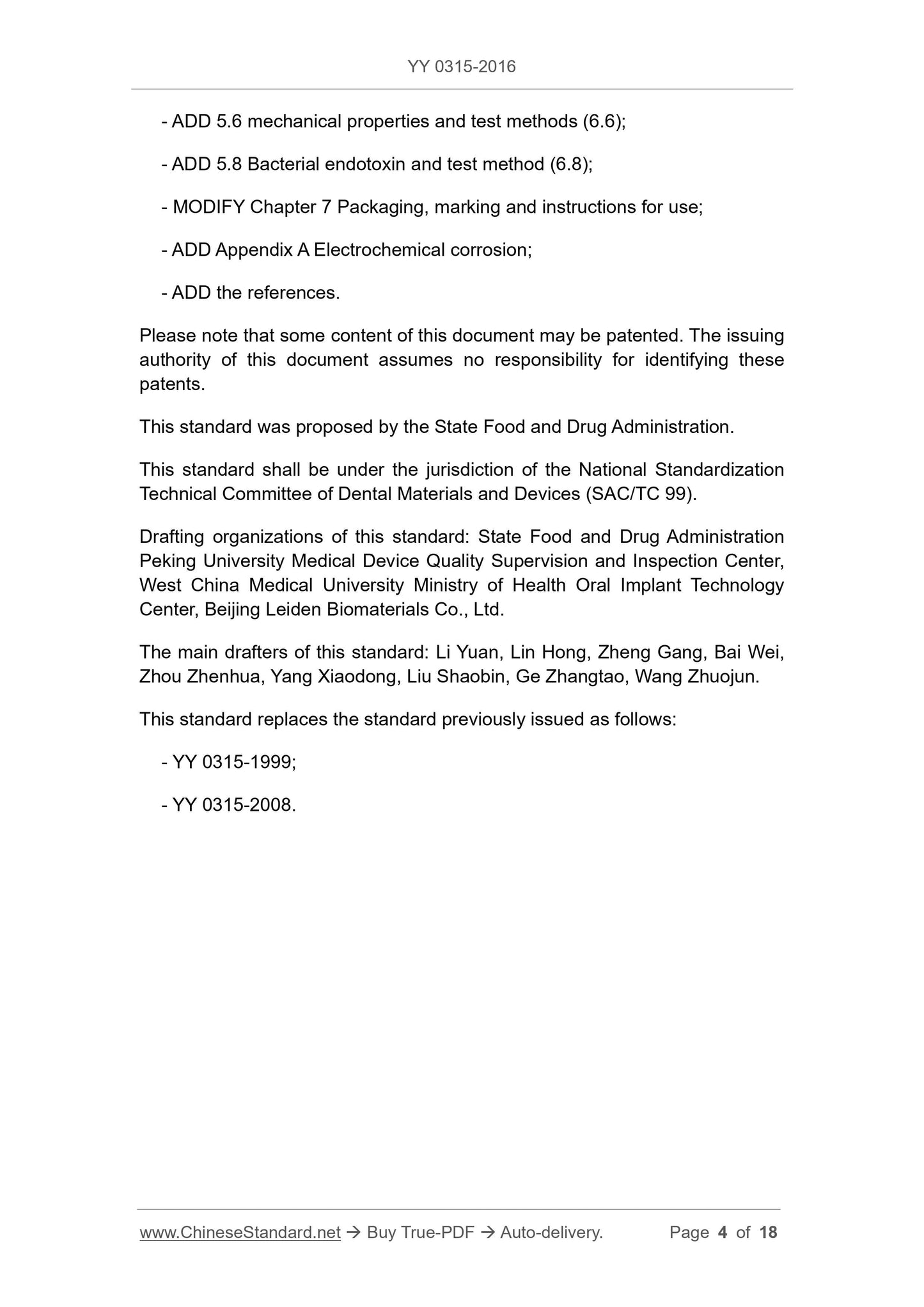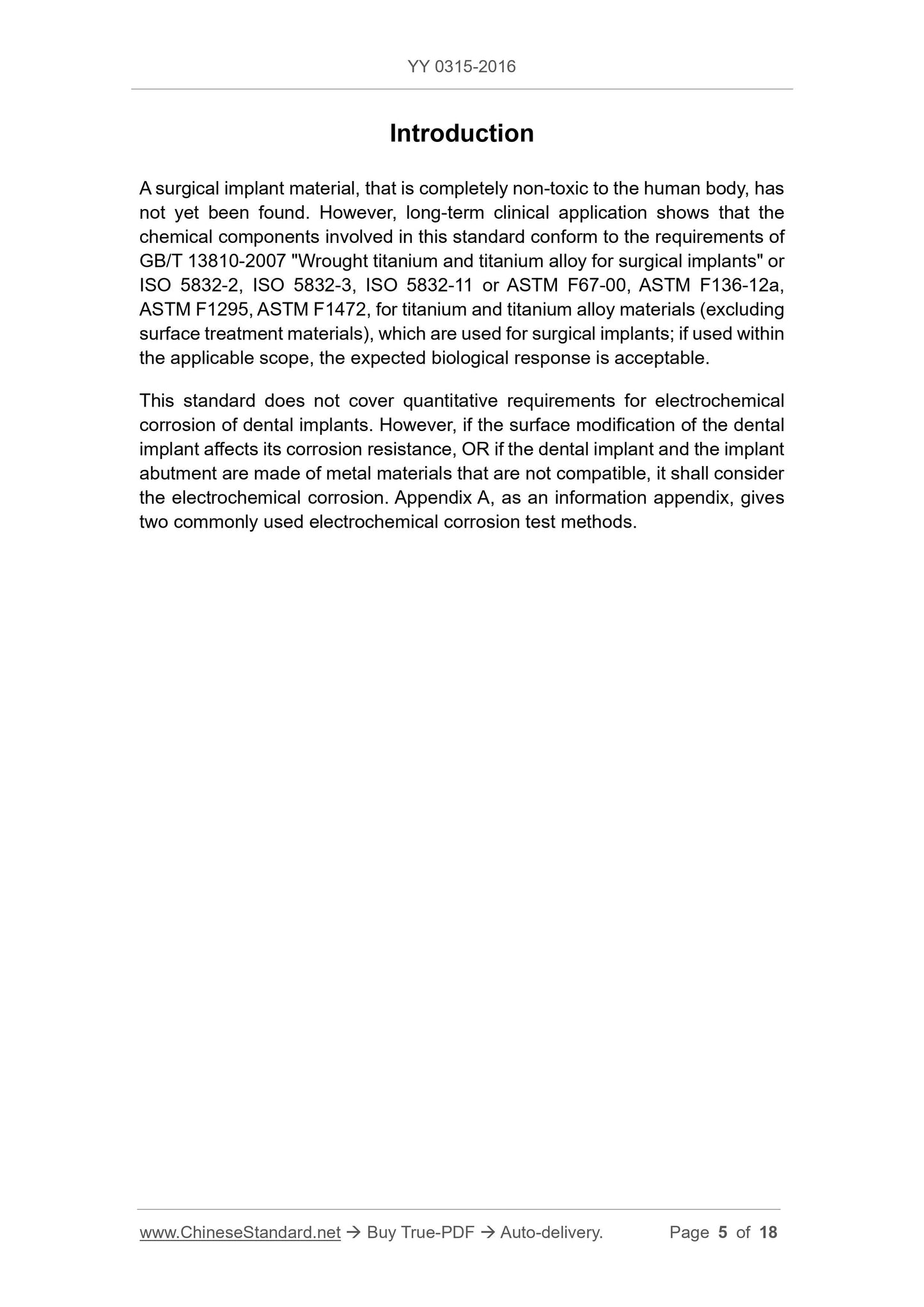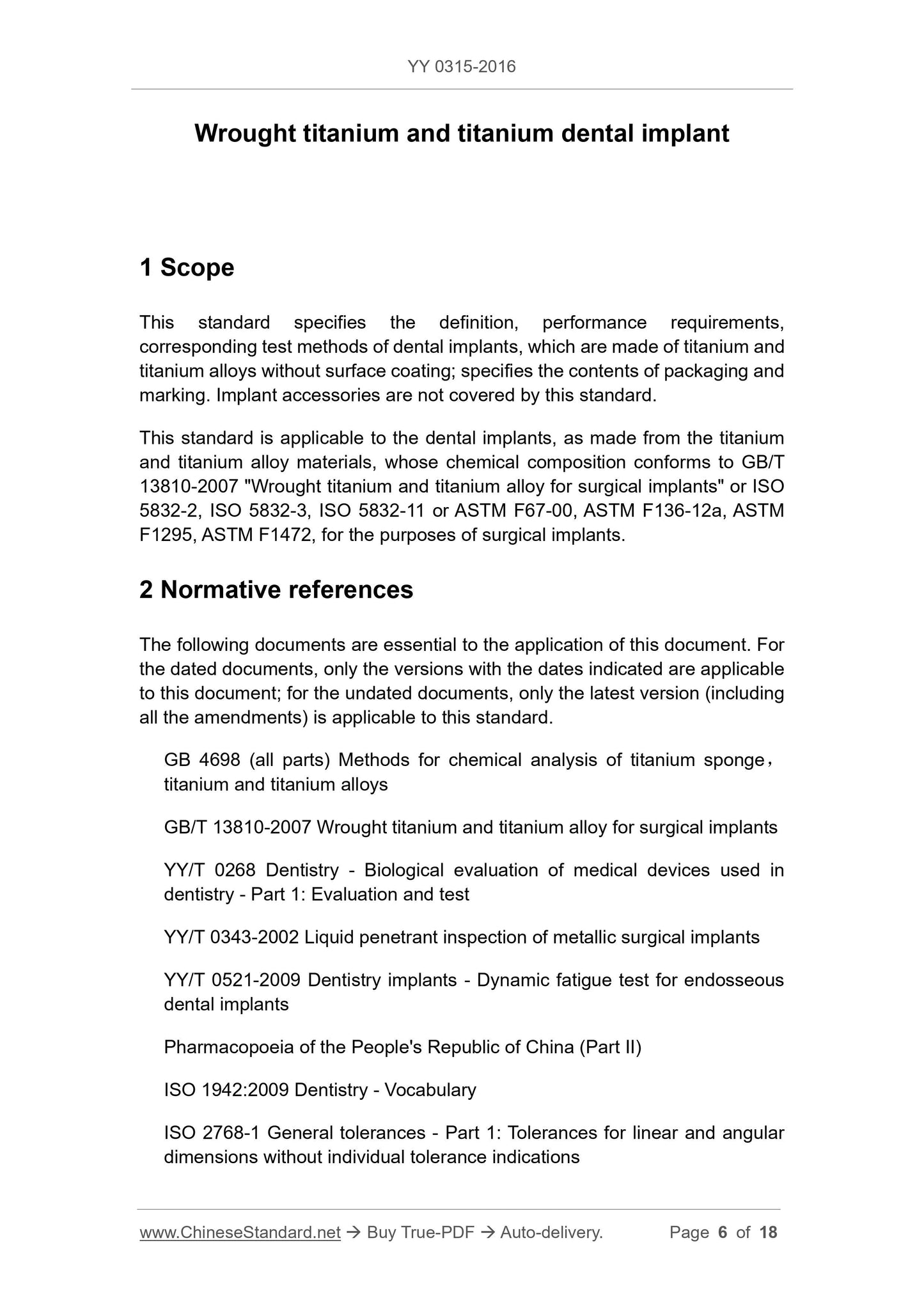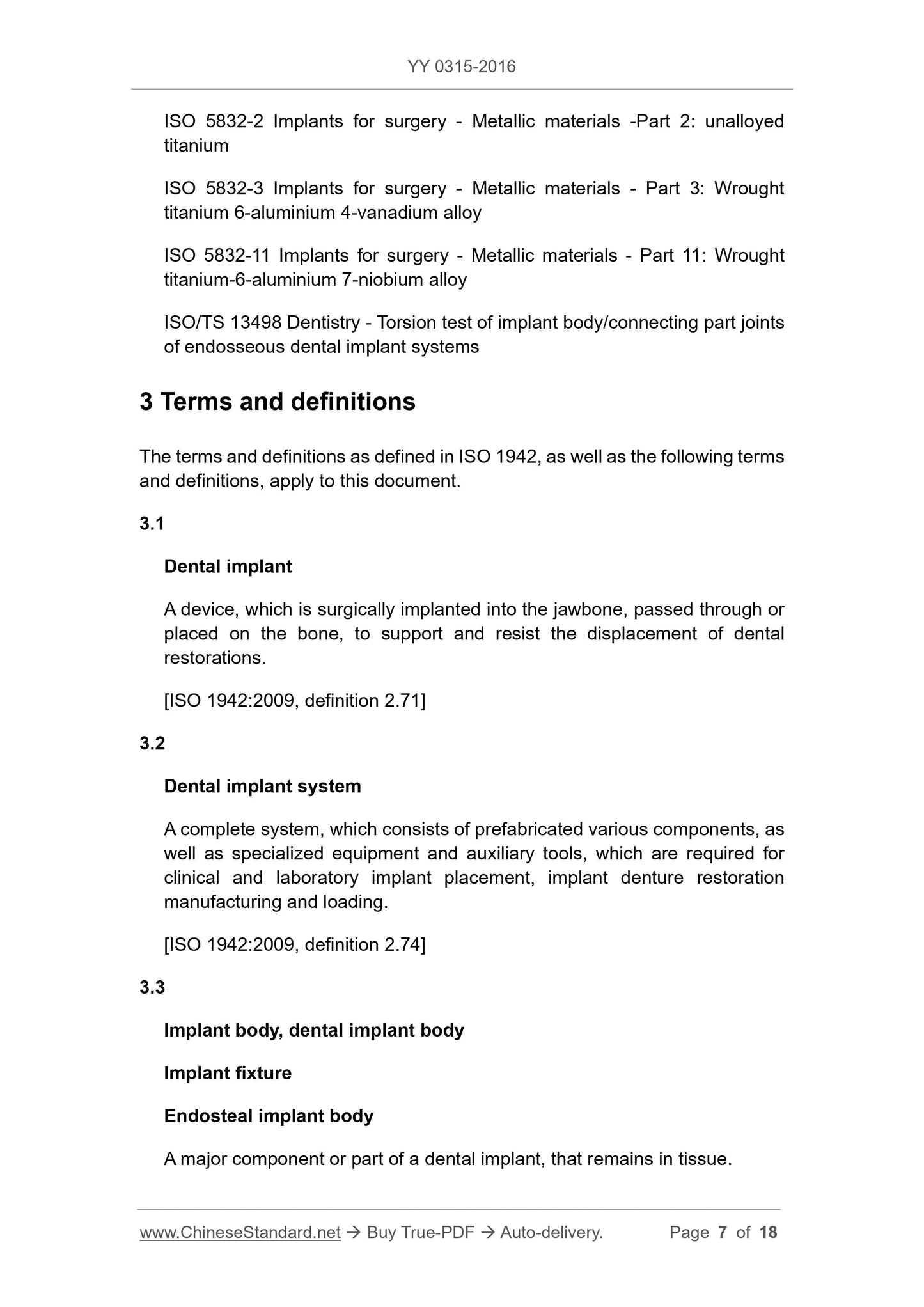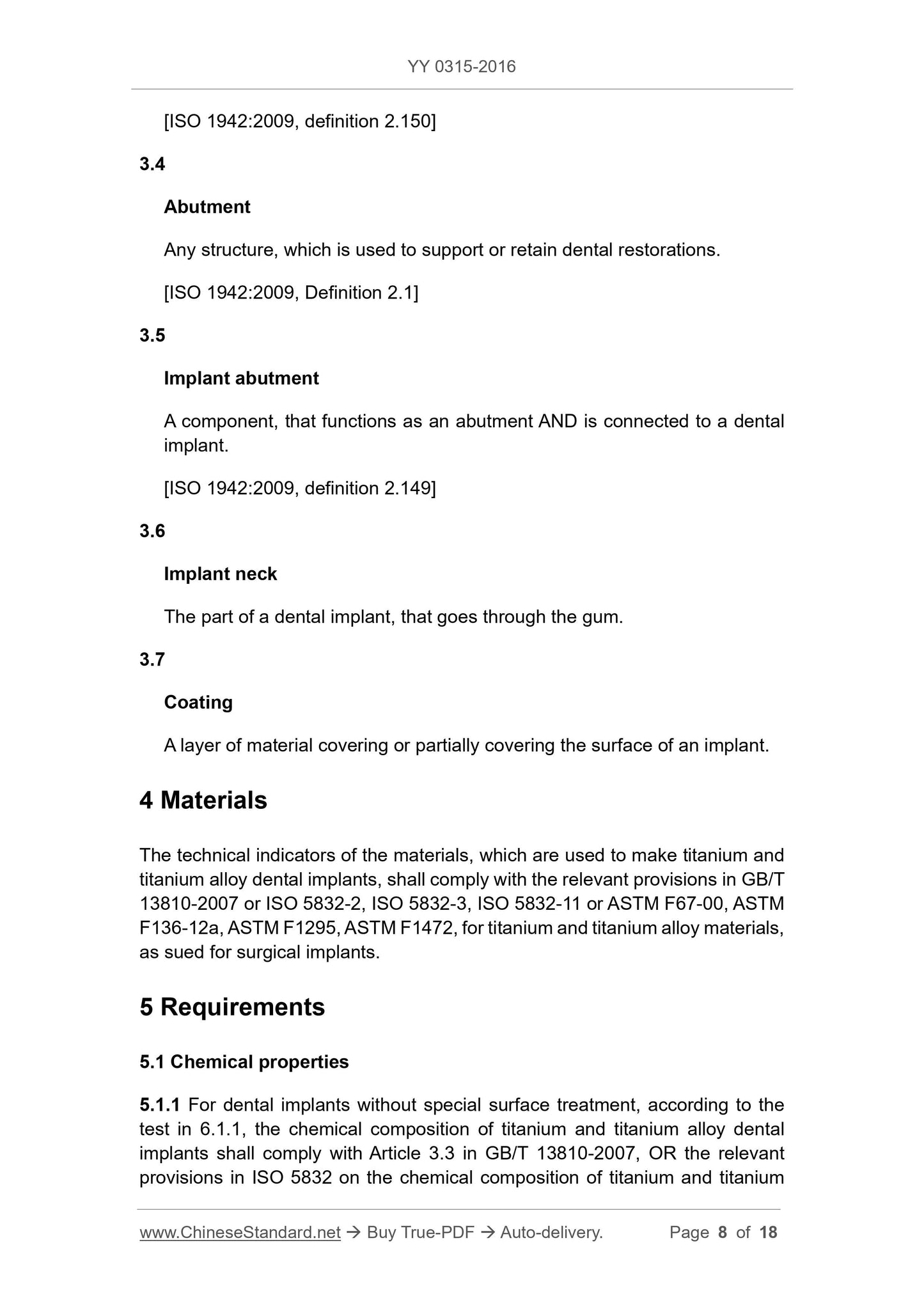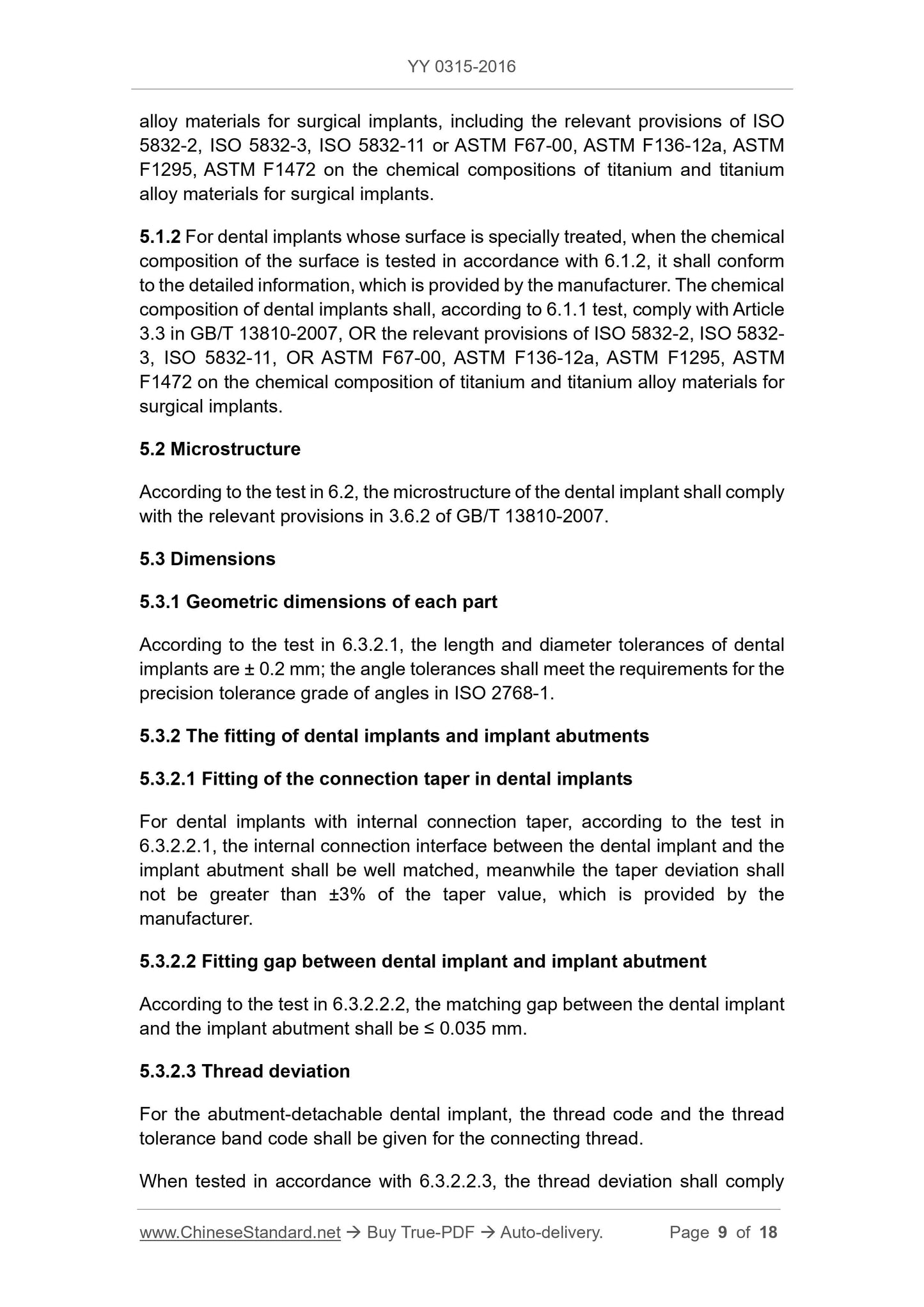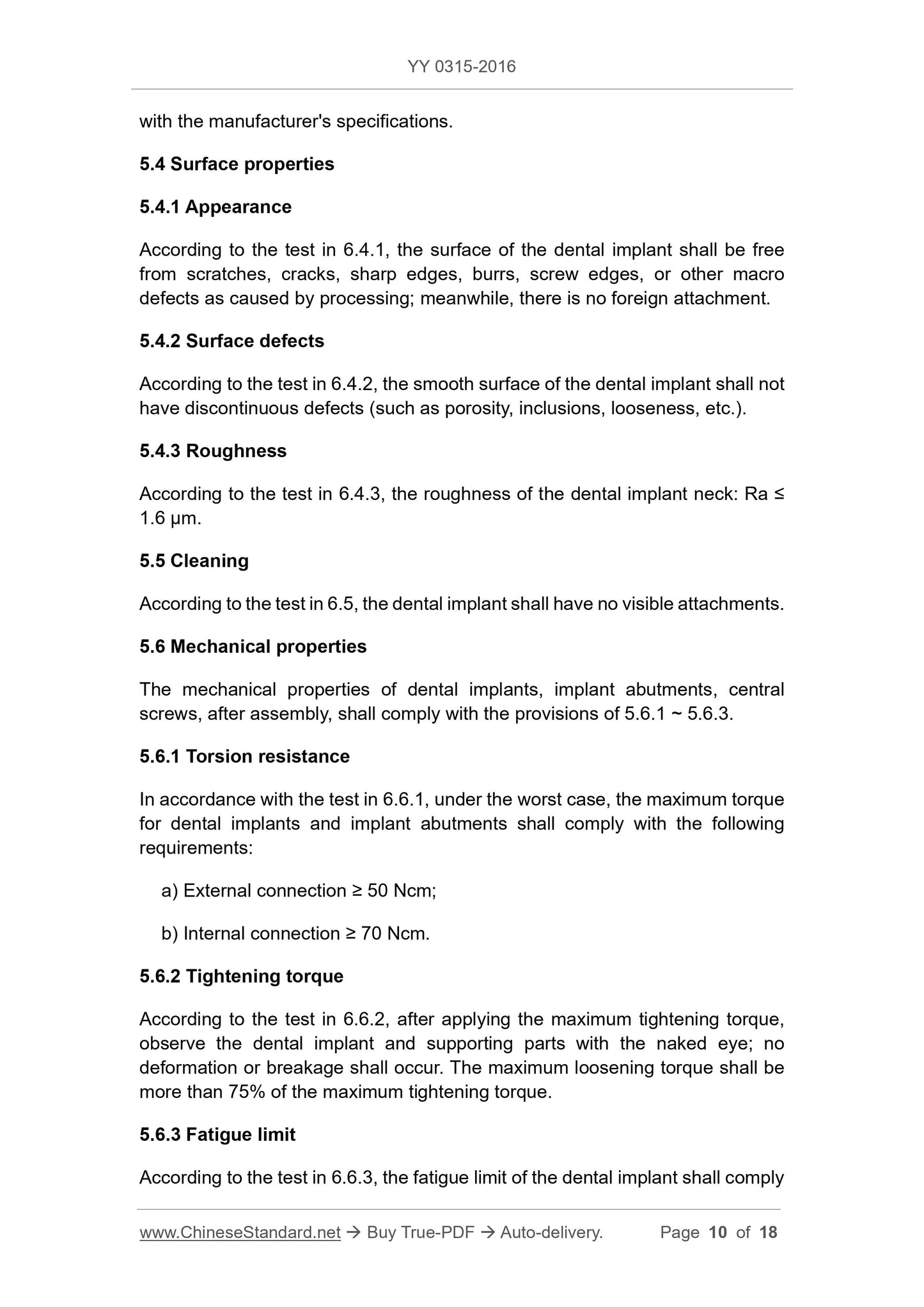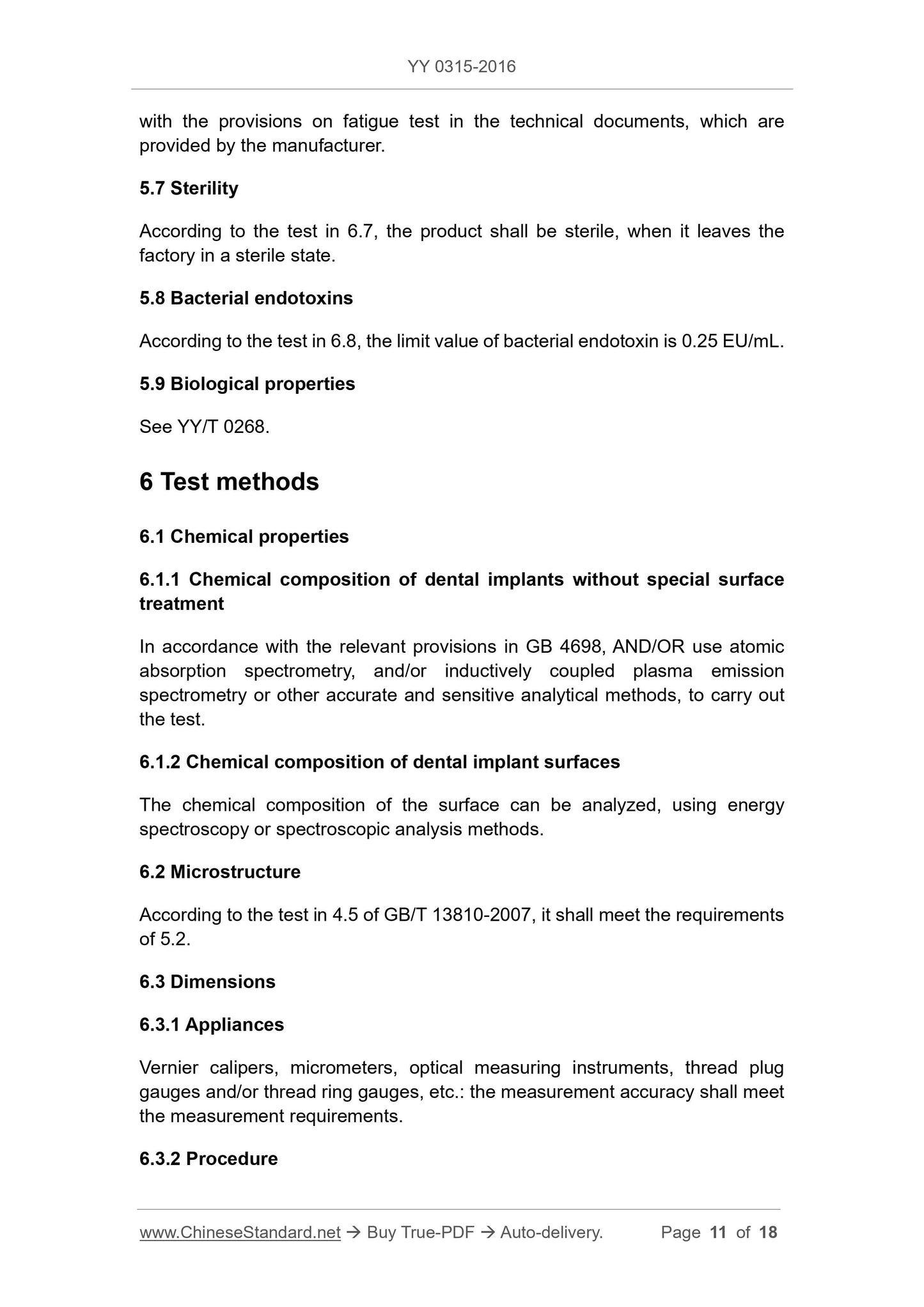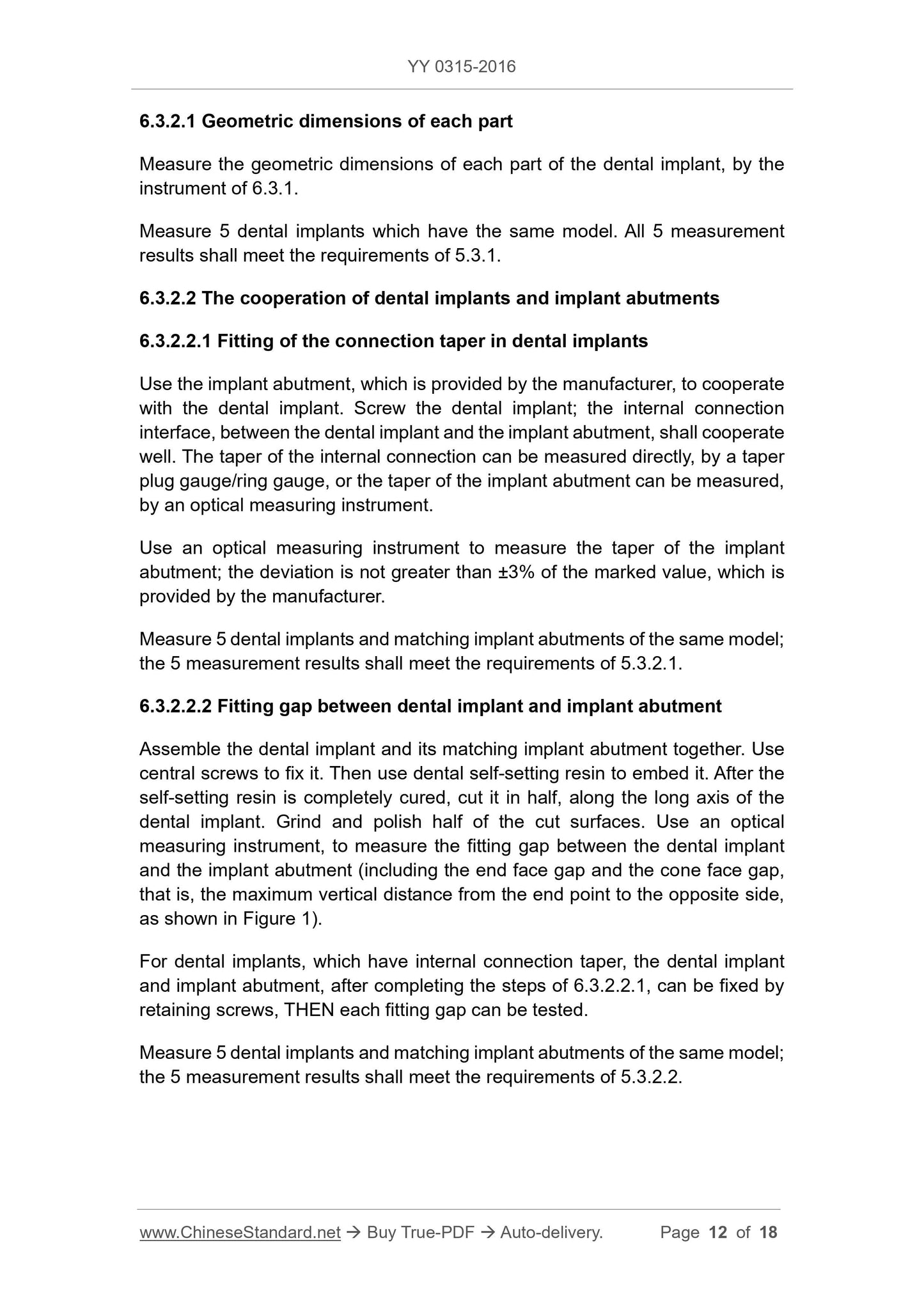1
/
of
12
PayPal, credit cards. Download editable-PDF & invoice in 1 second!
YY 0315-2016 English PDF (YY0315-2016)
YY 0315-2016 English PDF (YY0315-2016)
Regular price
$220.00 USD
Regular price
Sale price
$220.00 USD
Unit price
/
per
Shipping calculated at checkout.
Couldn't load pickup availability
Delivery: 3 seconds. Download true-PDF + Invoice.
Get QUOTATION in 1-minute: Click YY 0315-2016
Historical versions: YY 0315-2016
Preview True-PDF (Reload/Scroll if blank)
YY 0315-2016: Wrought titanium and titanium dental implant
YY 0315-2016
YY
PHARMACEUTICAL INDUSTRY STANDARD
OF THE PEOPLE’S REPUBLIC OF CHINA
ICS 11.060.10
C 33
Replacing YY 0315-2008
Wrought titanium and titanium dental implant
ISSUED ON: JANUARY 26, 2016
IMPLEMENTED ON: JANUARY 01, 2018
Issued by: State Food and Drug Administration
Table of Contents
Foreword ... 3
Introduction ... 5
1 Scope ... 6
2 Normative references ... 6
3 Terms and definitions ... 7
4 Materials ... 8
5 Requirements ... 8
6 Test methods ... 11
7 Packaging, marking, instructions for use ... 15
Appendix A (Informative) Electrochemical corrosion ... 17
References ... 18
Wrought titanium and titanium dental implant
1 Scope
This standard specifies the definition, performance requirements,
corresponding test methods of dental implants, which are made of titanium and
titanium alloys without surface coating; specifies the contents of packaging and
marking. Implant accessories are not covered by this standard.
This standard is applicable to the dental implants, as made from the titanium
and titanium alloy materials, whose chemical composition conforms to GB/T
13810-2007 "Wrought titanium and titanium alloy for surgical implants" or ISO
5832-2, ISO 5832-3, ISO 5832-11 or ASTM F67-00, ASTM F136-12a, ASTM
F1295, ASTM F1472, for the purposes of surgical implants.
2 Normative references
The following documents are essential to the application of this document. For
the dated documents, only the versions with the dates indicated are applicable
to this document; for the undated documents, only the latest version (including
all the amendments) is applicable to this standard.
GB 4698 (all parts) Methods for chemical analysis of titanium sponge,
titanium and titanium alloys
GB/T 13810-2007 Wrought titanium and titanium alloy for surgical implants
YY/T 0268 Dentistry - Biological evaluation of medical devices used in
dentistry - Part 1: Evaluation and test
YY/T 0343-2002 Liquid penetrant inspection of metallic surgical implants
YY/T 0521-2009 Dentistry implants - Dynamic fatigue test for endosseous
dental implants
Pharmacopoeia of the People's Republic of China (Part II)
ISO 1942:2009 Dentistry - Vocabulary
ISO 2768-1 General tolerances - Part 1: Tolerances for linear and angular
dimensions without individual tolerance indications
alloy materials for surgical implants, including the relevant provisions of ISO
5832-2, ISO 5832-3, ISO 5832-11 or ASTM F67-00, ASTM F136-12a, ASTM
F1295, ASTM F1472 on the chemical compositions of titanium and titanium
alloy materials for surgical implants.
5.1.2 For dental implants whose surface is specially treated, when the chemical
composition of the surface is tested in accordance with 6.1.2, it shall conform
to the detailed information, which is provided by the manufacturer. The chemical
composition of dental implants shall, according to 6.1.1 test, comply with Article
3.3 in GB/T 13810-2007, OR the relevant provisions of ISO 5832-2, ISO 5832-
3, ISO 5832-11, OR ASTM F67-00, ASTM F136-12a, ASTM F1295, ASTM
F1472 on the chemical composition of titanium and titanium alloy materials for
surgical implants.
5.2 Microstructure
According to the test in 6.2, the microstructure of the dental implant shall comply
with the relevant provisions in 3.6.2 of GB/T 13810-2007.
5.3 Dimensions
5.3.1 Geometric dimensions of each part
According to the test in 6.3.2.1, the length and diameter tolerances of dental
implants are ± 0.2 mm; the angle tolerances shall meet the requirements for the
precision tolerance grade of angles in ISO 2768-1.
5.3.2 The fitting of dental implants and implant abutments
5.3.2.1 Fitting of the connection taper in dental implants
For dental implants with internal connection taper, according to the test in
6.3.2.2.1, the internal connection interface between the dental implant and the
implant abutment shall be well matched, meanwhile the taper deviation shall
not be greater than ±3% of the taper value, which is provided by the
manufacturer.
5.3.2.2 Fitting gap between dental implant and implant abutment
According to the test in 6.3.2.2.2, the matching gap between the dental implant
and the implant abutment shall be ≤ 0.035 mm.
5.3.2.3 Thread deviation
For the abutment-detachable dental implant, the thread code and the thread
tolerance band code shall be given for the connecting thread.
When tested in accordance with 6.3.2.2.3, the thread deviation shall comply
with the manufacturer's specifications.
5.4 Surface properties
5.4.1 Appearance
According to the test in 6.4.1, the surface of the dental implant shall be free
from scratches, cracks, sharp edges, burrs, screw edges, or other macro
defects as caused by processing; meanwhile, there is no foreign attachment.
5.4.2 Surface defects
According to the test in 6.4.2, the smooth surface of the dental implant shall not
have discontinuous defects (such as porosity, inclusions, looseness, etc.).
5.4.3 Roughness
According to the test in 6.4.3, the roughness of the dental implant neck: Ra ≤
1.6 µm.
5.5 Cleaning
According to the test in 6.5, the dental implant shall have no visible attachments.
5.6 Mechanical properties
The mechanical properties of dental implants, implant abutments, central
screws, after assembly, shall comply with the provisions of 5.6.1 ~ 5.6.3.
5.6.1 Torsion resistance
In accordance with the test in 6.6.1, under the worst case, the maximum torque
for dental implants and implant abutments shall comply with the following
requirements:
a) External connection ≥ 50 Ncm;
b) Internal connection ≥ 70 Ncm.
5.6.2 Tightening torque
According to the test in 6.6.2, after applying the maximum tightening torque,
observe the dental implant and supporting parts with the naked eye; no
deformation or breakage shall occur. The maximum loosening torque shall be
more than 75% of the maximum tightening torque.
5.6.3 Fatigue limit
According to the test in 6.6.3, the fatigue limit of the dental implant shall comply
6.3.2.1 Geometric dimensions of each part
Measure the geometric dimensions of each part of the dental implant, by the
instrument of 6.3.1.
Measure 5 dental implants which have the same model. All 5 measurement
results shall meet the requirements of 5.3.1.
6.3.2.2 The cooperation of dental implants and implant abutments
6.3.2.2.1 Fitting of the connection taper in dental implants
Use the implant abutment, which is provided by the manufacturer, to cooperate
with the dental implant. Screw the dental implant; the internal connection
interface, between the dental implant and the implant abutment, shall cooperate
well. The taper of the internal connection can be measured directly, by a taper
plug gauge/ring gauge, or the taper of the implant abutment can be measured,
by an optical measuring instrument.
Use an optical measuring instrument to measure the taper of the implant
abutment; the deviation is not greater than ±3% of the marked value, which is
provided by the manufacturer.
Measure 5 dental implants and matching implant abutments of the same model;
the 5 measurement results shall meet the requirements of 5.3.2.1.
6.3.2.2.2 Fitting gap between dental implant and implant abutment
Assemble the dental implant and its matching implant abutment together. Use
central screws to fix it. Then use dental self-setting resin to embed it. After the
self-setting resin is completely cured, cut it in half, a...
Get QUOTATION in 1-minute: Click YY 0315-2016
Historical versions: YY 0315-2016
Preview True-PDF (Reload/Scroll if blank)
YY 0315-2016: Wrought titanium and titanium dental implant
YY 0315-2016
YY
PHARMACEUTICAL INDUSTRY STANDARD
OF THE PEOPLE’S REPUBLIC OF CHINA
ICS 11.060.10
C 33
Replacing YY 0315-2008
Wrought titanium and titanium dental implant
ISSUED ON: JANUARY 26, 2016
IMPLEMENTED ON: JANUARY 01, 2018
Issued by: State Food and Drug Administration
Table of Contents
Foreword ... 3
Introduction ... 5
1 Scope ... 6
2 Normative references ... 6
3 Terms and definitions ... 7
4 Materials ... 8
5 Requirements ... 8
6 Test methods ... 11
7 Packaging, marking, instructions for use ... 15
Appendix A (Informative) Electrochemical corrosion ... 17
References ... 18
Wrought titanium and titanium dental implant
1 Scope
This standard specifies the definition, performance requirements,
corresponding test methods of dental implants, which are made of titanium and
titanium alloys without surface coating; specifies the contents of packaging and
marking. Implant accessories are not covered by this standard.
This standard is applicable to the dental implants, as made from the titanium
and titanium alloy materials, whose chemical composition conforms to GB/T
13810-2007 "Wrought titanium and titanium alloy for surgical implants" or ISO
5832-2, ISO 5832-3, ISO 5832-11 or ASTM F67-00, ASTM F136-12a, ASTM
F1295, ASTM F1472, for the purposes of surgical implants.
2 Normative references
The following documents are essential to the application of this document. For
the dated documents, only the versions with the dates indicated are applicable
to this document; for the undated documents, only the latest version (including
all the amendments) is applicable to this standard.
GB 4698 (all parts) Methods for chemical analysis of titanium sponge,
titanium and titanium alloys
GB/T 13810-2007 Wrought titanium and titanium alloy for surgical implants
YY/T 0268 Dentistry - Biological evaluation of medical devices used in
dentistry - Part 1: Evaluation and test
YY/T 0343-2002 Liquid penetrant inspection of metallic surgical implants
YY/T 0521-2009 Dentistry implants - Dynamic fatigue test for endosseous
dental implants
Pharmacopoeia of the People's Republic of China (Part II)
ISO 1942:2009 Dentistry - Vocabulary
ISO 2768-1 General tolerances - Part 1: Tolerances for linear and angular
dimensions without individual tolerance indications
alloy materials for surgical implants, including the relevant provisions of ISO
5832-2, ISO 5832-3, ISO 5832-11 or ASTM F67-00, ASTM F136-12a, ASTM
F1295, ASTM F1472 on the chemical compositions of titanium and titanium
alloy materials for surgical implants.
5.1.2 For dental implants whose surface is specially treated, when the chemical
composition of the surface is tested in accordance with 6.1.2, it shall conform
to the detailed information, which is provided by the manufacturer. The chemical
composition of dental implants shall, according to 6.1.1 test, comply with Article
3.3 in GB/T 13810-2007, OR the relevant provisions of ISO 5832-2, ISO 5832-
3, ISO 5832-11, OR ASTM F67-00, ASTM F136-12a, ASTM F1295, ASTM
F1472 on the chemical composition of titanium and titanium alloy materials for
surgical implants.
5.2 Microstructure
According to the test in 6.2, the microstructure of the dental implant shall comply
with the relevant provisions in 3.6.2 of GB/T 13810-2007.
5.3 Dimensions
5.3.1 Geometric dimensions of each part
According to the test in 6.3.2.1, the length and diameter tolerances of dental
implants are ± 0.2 mm; the angle tolerances shall meet the requirements for the
precision tolerance grade of angles in ISO 2768-1.
5.3.2 The fitting of dental implants and implant abutments
5.3.2.1 Fitting of the connection taper in dental implants
For dental implants with internal connection taper, according to the test in
6.3.2.2.1, the internal connection interface between the dental implant and the
implant abutment shall be well matched, meanwhile the taper deviation shall
not be greater than ±3% of the taper value, which is provided by the
manufacturer.
5.3.2.2 Fitting gap between dental implant and implant abutment
According to the test in 6.3.2.2.2, the matching gap between the dental implant
and the implant abutment shall be ≤ 0.035 mm.
5.3.2.3 Thread deviation
For the abutment-detachable dental implant, the thread code and the thread
tolerance band code shall be given for the connecting thread.
When tested in accordance with 6.3.2.2.3, the thread deviation shall comply
with the manufacturer's specifications.
5.4 Surface properties
5.4.1 Appearance
According to the test in 6.4.1, the surface of the dental implant shall be free
from scratches, cracks, sharp edges, burrs, screw edges, or other macro
defects as caused by processing; meanwhile, there is no foreign attachment.
5.4.2 Surface defects
According to the test in 6.4.2, the smooth surface of the dental implant shall not
have discontinuous defects (such as porosity, inclusions, looseness, etc.).
5.4.3 Roughness
According to the test in 6.4.3, the roughness of the dental implant neck: Ra ≤
1.6 µm.
5.5 Cleaning
According to the test in 6.5, the dental implant shall have no visible attachments.
5.6 Mechanical properties
The mechanical properties of dental implants, implant abutments, central
screws, after assembly, shall comply with the provisions of 5.6.1 ~ 5.6.3.
5.6.1 Torsion resistance
In accordance with the test in 6.6.1, under the worst case, the maximum torque
for dental implants and implant abutments shall comply with the following
requirements:
a) External connection ≥ 50 Ncm;
b) Internal connection ≥ 70 Ncm.
5.6.2 Tightening torque
According to the test in 6.6.2, after applying the maximum tightening torque,
observe the dental implant and supporting parts with the naked eye; no
deformation or breakage shall occur. The maximum loosening torque shall be
more than 75% of the maximum tightening torque.
5.6.3 Fatigue limit
According to the test in 6.6.3, the fatigue limit of the dental implant shall comply
6.3.2.1 Geometric dimensions of each part
Measure the geometric dimensions of each part of the dental implant, by the
instrument of 6.3.1.
Measure 5 dental implants which have the same model. All 5 measurement
results shall meet the requirements of 5.3.1.
6.3.2.2 The cooperation of dental implants and implant abutments
6.3.2.2.1 Fitting of the connection taper in dental implants
Use the implant abutment, which is provided by the manufacturer, to cooperate
with the dental implant. Screw the dental implant; the internal connection
interface, between the dental implant and the implant abutment, shall cooperate
well. The taper of the internal connection can be measured directly, by a taper
plug gauge/ring gauge, or the taper of the implant abutment can be measured,
by an optical measuring instrument.
Use an optical measuring instrument to measure the taper of the implant
abutment; the deviation is not greater than ±3% of the marked value, which is
provided by the manufacturer.
Measure 5 dental implants and matching implant abutments of the same model;
the 5 measurement results shall meet the requirements of 5.3.2.1.
6.3.2.2.2 Fitting gap between dental implant and implant abutment
Assemble the dental implant and its matching implant abutment together. Use
central screws to fix it. Then use dental self-setting resin to embed it. After the
self-setting resin is completely cured, cut it in half, a...
Share
